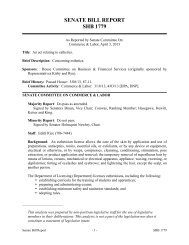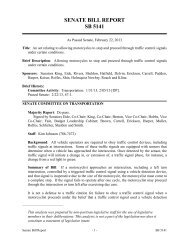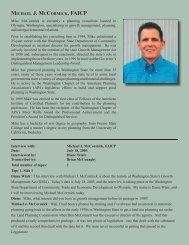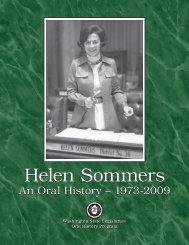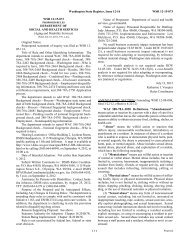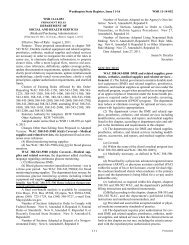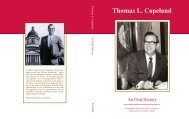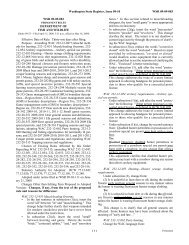Proposed
Proposed
Proposed
You also want an ePaper? Increase the reach of your titles
YUMPU automatically turns print PDFs into web optimized ePapers that Google loves.
WSR 12-21-125 Washington State Register, Issue 12-21<br />
(iii) Involves constructing a personal wireless service<br />
tower less than sixty feet in height that is located in a commercial,<br />
industrial, manufacturing, forest, or agricultural<br />
zone.<br />
(b) For the purposes of this subsection:<br />
(i) "Personal wireless services" means commercial<br />
mobile services, unlicensed wireless services, and common<br />
carrier wireless exchange access services, as defined by federal<br />
laws and regulations.<br />
(ii) "Personal wireless service facilities" means facilities<br />
for the provision of personal wireless services.<br />
(iii) "Microcell" means a wireless communication facility<br />
consisting of an antenna that is either:<br />
(A) Four feet in height and with an area of not more than<br />
five hundred eighty square inches; or<br />
(B) If a tubular antenna, no more than four inches in<br />
diameter and no more than six feet in length.<br />
(c) This exemption does not apply to projects within a<br />
critical area designated under GMA (RCW 36.70A.060).<br />
AMENDATORY SECTION (Amending Order DE 83-39,<br />
filed 2/10/84, effective 4/4/84)<br />
WAC 197-11-906 Content and consistency of agency<br />
procedures. (1)(a) Agency SEPA policies and procedures<br />
shall implement and be consistent with the rules in this chapter.<br />
Unless optional or permissive (see WAC 197-11-704), all<br />
of the provisions of this chapter are mandatory, and agency<br />
procedures shall incorporate these rules and criteria.<br />
(b) Permissive and optional rules shall not be construed<br />
as mandatory requirements. Rules giving encouragement or<br />
guidance shall also not be construed as mandatory. The decision<br />
on whether to apply an optional provision rests with the<br />
responsible official.<br />
(c) Except as stated in the next subsection, the rules in<br />
this chapter are not exclusive, and agencies may add procedures<br />
and criteria. However, any additional material shall not<br />
be inconsistent with, contradict, or make compliance with<br />
any provision of these rules a practical impossibility. Any<br />
additional material shall be consistent with SEPA.<br />
(d) Agency procedures shall also include the procedures<br />
required by sections WAC 197-11-055 (3)(a) and (4), 197-<br />
11-420 (1) and (4), and 197-11-910.<br />
(e) Agency procedures may include procedures under<br />
WAC 197-11-055 (2) and (7), 197-11-100(3), 197-11-680,<br />
197-11-714(2), 197-11-800(1), and 197-11-908. Any such<br />
procedures shall include the content required by those rules.<br />
(2) The following provisions of this chapter are exclusive<br />
and may not be added to or changed in agency procedures:<br />
(a) The definitions of "proposal," "major," "action," "significant,"<br />
"affecting," "environment," "categorical exemption,"<br />
"agencies with jurisdiction," "lands covered by water,"<br />
"built environment," "natural environment," "license,"<br />
"licensing," "mitigation," and "scope";<br />
(b) The criteria for lead agency determination (Part Ten<br />
of these rules);<br />
(c) The categorical exemptions in Part Nine of these<br />
rules, unless expressly allowed under Part Nine;<br />
<strong>Proposed</strong> [ 174 ]<br />
(d) The information allowed to be required of applicants<br />
under WAC 197-11-080, 197-11-100, 197-11-335, and 197-<br />
11-420;<br />
(e) The requirements for the style and size of an EIS<br />
(WAC 197-11-425);<br />
(f) The list of elements of the environment (WAC 197-<br />
11-444); and<br />
(g) The provisions on substantive authority and mitigation<br />
in WAC 197-11-660.<br />
(3) The following provisions of this chapter may not be<br />
changed, but may be added to; any additions shall meet the<br />
criteria for additional material stated in subsection (1)(c) of<br />
this section:<br />
(a) All other definitions in Part Eight of these rules;<br />
(b) The provisions in Parts Four and Five of these rules,<br />
except as necessary to be grammatically incorporated into<br />
agency procedures;<br />
(c) The contents of agency SEPA procedures (WAC<br />
197-11-906); and<br />
(d) The list of agencies with environmental expertise<br />
(WAC 197-11-920).<br />
(4) The forms in Part Eleven shall be used substantially<br />
as set forth. Minor changes are allowed to make the forms<br />
more useful to agencies, applicants, and the public, as long as<br />
the changes do not eliminate requested information or impose<br />
burdens on applicants. ((The questions in Part Two of the<br />
environmental checklist shall not be altered.))<br />
AMENDATORY SECTION (Amending Order DE 83-39,<br />
filed 2/10/84, effective 4/4/84)<br />
WAC 197-11-960 Environmental checklist.<br />
Purpose of checklist:<br />
ENVIRONMENTAL CHECKLIST<br />
The State Environmental Policy Act (SEPA), chapter<br />
43.21C RCW, requires all governmental agencies to consider<br />
the environmental impacts of a proposal before making decisions.<br />
An environmental impact statement (EIS) must be prepared<br />
for all proposals with probable significant adverse<br />
impacts on the quality of the environment. The purpose of<br />
this checklist is to provide information to help you and the<br />
agency identify impacts from your proposal (and to reduce or<br />
avoid impacts from the proposal, if it can be done) and to help<br />
the agency decide whether an EIS is required.<br />
Instructions for applicants:<br />
This environmental checklist asks you to describe some<br />
basic information about your proposal. Governmental agencies<br />
use this checklist to determine whether the environmental<br />
impacts of your proposal are significant, requiring preparation<br />
of an EIS. Answer the questions briefly, with the most<br />
precise information known, or give the best description you<br />
can.<br />
You must answer each question accurately and carefully,<br />
to the best of your knowledge. In most cases, you should be<br />
able to answer the questions from your own observations or<br />
project plans without the need to hire experts. If you really do<br />
not know the answer, or if a question does not apply to your<br />
proposal, write "do not know" or "does not apply." Complete



